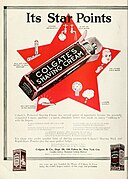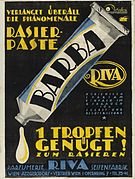Shaving soap

The shaving soap is a special form of soap for wet shaving . In contrast to the shaving foam from the can, the soap has to be lathered with a shaving brush . This disadvantage meant that it was used less and less for decades. Only with the comeback of the full beard and the associated barbers did shaving soap make a comeback.
history
Shaving soap in its modern form has been around since the 19th century. The American manufacturer "Williams" has been producing them commercially since 1840.
After the first canned shaving foam was introduced in the United States in 1949 , sales of shaving soaps that had to be mixed by yourself declined. As early as 1958, 27.65% less shaving soap was being produced in one piece in West Germany than in the previous year. In the case of bar-shaped shaving soap, production fell by 13.55% in 1958 compared to the previous year. This trend continued. In 1964, only 17 tons of shaving soap were produced, compared to the annual production of 1957, when it was 65 tons in West Germany.
application
The purpose of every shaving soap is to produce a fine-bubble and dense foam that softens the whiskers and straightens them so that they can be cut as deeply as possible with a razor. Shaving soap is available in different dosage forms. It is often widespread in four variants.
Hard shaving soap

Hard shaving soap is usually offered as a bar or in a small pot . If it is available as a piece, it is placed in a small bowl. With both variants, the shaving brush is now wet and then moved back and forth in a circle on the shaving soap. The result is a foam that can be applied directly with a brush in a circle and is further foamed on the face. Alternatively, you can scrape off a small amount of the soap from the bar or from the pan with the help of a small slicer and then foam it up in a separate bowl. A third variant provides that you first spread the moistened brush on the soap for about three seconds and then lather it in a separate container for about 60 seconds. Compared to other beard care products, hard shaving soaps are considered to be particularly sustainable because they are only used very slowly and can then be replaced as a piece.
Soft shaving soap
Soft shaving soap is usually offered in a jar. In contrast to hard soap, it already has a soft or creamy consistency. Like the hard shaving soap, it is whipped in the pan with the help of a shaving brush while increasing the amount of water. In contrast to the hard shaving soap, the soft shaving soap has a different foam behavior.
Shaving cream
Like the soft shaving soap, the shaving cream has a creamy consistency. However, it is usually given in tubes. In contrast to shaving soap, it can be applied directly (without a shaving brush) to the skin, where it then foams. This type of shave is preferred by people with dry, low-fat skin, as it is easier on the skin than a lather shave. Non-foaming shaving creams chemically consist of over-greased stearate creams with emulsifiers , such as. B. triethanolamine , nonionic surfactants , lubricants ( paraffin oil , petrolatum , wool wax, etc.), humectants (glycerine, sorbitol, etc.) and other auxiliaries ( alginates , methyl cellulose, etc.) and preservatives .
Colgate company advert for shaving cream from 1910.
“Barbasol” shaving cream specially produced for the United States Army .
Razor pen
In principle, the razor stick works like the hard shaving soap. The difference, however, is that the bar of soap is attached in a screw sleeve, like a glue stick . For use, soap is applied to the moistened beard with the razor pen. Then the soap is massaged into the beard by hand for about 1 minute and then lathered with the shaving brush. Due to the small amount of soap removed, such a stick usually lasts longer than a comparable amount of hard shaving soap. the foam, on the other hand, is at least as creamy. Alternatively, as with the hard soap, pieces can be planed off or the foam can be foamed separately in a small bowl.
The razor stick should not be confused with the alum stick , which is also referred to as a razor stick in some publications.
composition
Shaving soap is made from stearin and coconut oil with a high proportion of stearic acid so that the foam is creamy and remains stable. It is not only saponified with caustic soda, but often with a portion of caustic potash. This makes the shaving soap smoother and easier to lather.
The chemist Eugen Dieterich describes a recipe for shaving soap in 1919. According to this, 600 g of mutton tallow , 350 g of coconut oil and 50 g of pure wool fat have to be melted, allowed to cool to 30 ° C and then 400 ml of sodium hydroxide solution and 20 g of “crystallized soda ” are stirred in until a uniform mass is formed. Then add 80 ml of water, 20 ml of alcohol (90% by volume), 1 ml each of bergamot and lavender oil , and 1 g of Peruvian balsam , as well as 10 drops of caraway oil and 5 drops of clove oil and cinnamon oil each . This mixture should be poured into a wooden box lined with wet parchment paper and left for four days in a room warm or even warmer place. During this time, the finished shaving soap should be created through self-heating and soap formation . This recipe can be supplemented by adding 30 g Salol ® ( phenyl salicylate ) “as long as the mass is warm and sticky” (probably after adding caustic soda and soda) . The shaving soap should therefore have an antiseptic effect and act as a good "remedy and protective agent " against beard lichen .
In 1931 the pharmacist Richard Brieger describes another recipe for a liquid shaving soap. For this, 30 g of grade 1A soap tallow and 12 g of coconut oil are melted in a kettle at 38 ° C and mixed with 18.5 g of 50 percent potassium hydroxide solution, which is 18 ° C warm. As soon as an emulsion has formed, the mixture should be stored well protected against heat loss "until the contents of the kettle have become completely clear". Then add 30 g of alcohol (96% by volume), stir and warm up until a clear, honey-like mass has formed. Then stir in 35 g of warmed glycerine and a solution of 4 g of potash and 15 ml of water and perfume as desired. He also describes a recipe for a transparent shaving soap.
Modern shaving soaps are usually a mixture of sodium and potassium soap , humectants , water and fragrances.
Popular fragrances of classic shaving soaps are Indian sandalwood , citrus and fern .
Web links
- mantic59: How To Make Traditional Shave Lather. In: youtube.com. 2007, accessed August 9, 2018 .
literature
- Marina Bährle-Rapp: Shaving soap . In: Springer Lexicon Cosmetics and Body Care . 3rd edition Springer, Berlin, Heidelberg 2007, ISBN 978-3-540-71095-0 , pp. 468-469 .
- Eugen Dieterich, Karl Dieterich: shaving soap . In: New Pharmaceutical Manual . Twelfth, little changed edition. Springer, Berlin, Heidelberg 1919, ISBN 978-3-662-36423-9 , pp. 446 ( Online [accessed August 9, 2018]).
- Richard Brieger: Shaving tires . In: Manual of the pharmaceutical newspaper . Springer Berlin Heidelberg, Berlin, Heidelberg 1931, ISBN 978-3-642-98770-0 , Aids for Shaving, p. 23-26 , doi : 10.1007 / 978-3-642-99585-9_13 .
- Günter Vollmer, Manfred Franz: Chemical products in everyday life: Eating a. Drinking, health and Body care, cleaning, fertilization, etc. Pest Control . German Paperback publ. u. a., Munich 1985, ISBN 3-423-03276-6 , pp. 150 f .
Individual evidence
- ↑ Sabine Kelle: Care: Well looked after: Tips from the professional barber . In: www.t-online.de . Ströer, Frankfurt am Main September 14, 2015 ( t-online.de [accessed August 9, 2018]).
- ↑ Williams Mug Soap product website . Archived from the original on July 18, 2011. Retrieved November 5, 2010.
- ^ History of Carter-Wallace, Inc. In: fundinguniverse.com. FundingUniverse, accessed August 9, 2018 .
- ↑ a b c C. Harz: Soap, detergent and cleaning agent production in 1958 . In: fats, soaps, paints . tape 61 , no. 4 , 1959, ISSN 0015-038X , p. 335-338 , doi : 10.1002 / lipi.19590610423 .
- ↑ C. Harz: The production of soaps, detergents and cleaning agents in 1964 . In: fats, soaps, paints . tape 67 , no. 5 , 1965, ISSN 0015-038X , p. 377-381 , doi : 10.1002 / lipi.19650670517 .
- ↑ a b Marina Bährle-Rapp: Springer Lexicon Cosmetics and Body Care . Springer, Berlin Heidelberg New York Barcelona Hong Kong London Milan Paris Singapore Tokyo 2001, ISBN 3-540-67888-3 , p. 357 f .
- ↑ a b c Shaving soap for the classic wet shave. In: dambiro.de. Retrieved August 9, 2018 .
- ↑ a b c Bernhard Roetzel, Günter Beer: The gentleman: the standard work of classic men's fashion . Updated new edition edition. hf ullmann, Rheinbreitbach, Germany 2019, ISBN 978-3-8480-1186-5 , p. 14th ff .
- ↑ a b Günter Vollmer, Manfred Franz: Chemical products in everyday life: Essen u. Drinking, health and Body care, cleaning, fertilization, etc. Pest Control . German Paperback publ. u. a., Munich 1985, ISBN 3-423-03276-6 , pp. 150 f .
- ^ Eugen Dieterich, Karl Dieterich: Shaving soap. Sapo ad Barbam. In: New Pharmaceutical Manual . Twelfth, little changed edition. Springer, Berlin, Heidelberg 1919, ISBN 978-3-662-36423-9 , pp. 446 ( Online [accessed August 9, 2018]).
- ↑ Eugen Dieterich, Karl Dieterich: shaving soap, antiseptic. Salol shaving soap . In: New Pharmaceutical Manual . Twelfth, little changed edition. Springer, Berlin, Heidelberg 1919, ISBN 978-3-662-36423-9 , pp. 446 ( Online [accessed August 9, 2018]).
- ↑ a b Richard Brieger: Shaving Soaps . In: Manual of the pharmaceutical newspaper . Springer Berlin Heidelberg, Berlin, Heidelberg 1931, ISBN 978-3-642-98770-0 , Aids for Shaving, p. 23-26 , doi : 10.1007 / 978-3-642-99585-9_13 .






